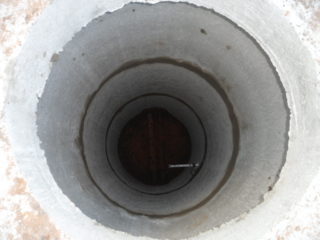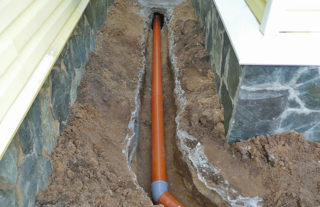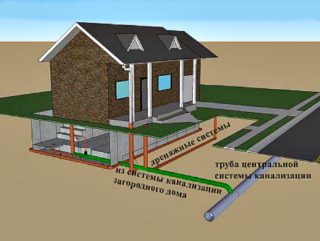When building a personal estate, it is important to create a high-quality sewage system. If the private sector is located within the city limits, it is worth, if possible, to connect to the central sewerage system.
Advantages of joining a centralized sewage system

Connection to the central sewer line allows:
- Save on material costs. You do not have to purchase equipment for arranging a septic tank and its maintenance. The costs will be minimal.
- Get rid of worries about the cleanliness of drains. Service organizations undertake this function.
- Use the sewer for a long time, having connected once.
All that is required for the normal functioning of the system is making a monthly payment.
Collection of required documents and permits
After planning the connection, contact the geodetic organization to develop a schematic plan. It is created on the technical plan of the building and the land plot. It is possible to reduce the cost of surveying by connecting houses to a centralized sewer network together with neighbors.
From additional documents you will need:
- Technical conditions for connecting highways. Created by an organization that maintains sewerage systems.
- The project of connecting the branch to the city-wide sewerage system. It is drawn up by a design engineer on the basis of a schematic plan and technical specifications.
- Resolution of project documents in the water utility and architecture department.
Further, the owner of the house applies with a package of documents to the company serving the city sewage system, most often it is a water utility.
Additional approval of the project with supervisory organizations is required, the mains of which may be located on the planned sewerage path. These include the car inspection (when laying through the road), companies that supervise the operation of heat and power supply networks. In addition, the consent of residents of neighboring houses may be required to carry out construction and installation work in the vicinity of their homestead territories.
Preparatory work

Preparation is carried out in the following sequence:
- A well is being installed for revision. Conducting sewer networks in a private house with a connection to a city-wide highway is possible only if it is available for access during emergency or planned cleaning.
- A trench is dug and a place is prepared where the drain pipeline will be connected to the well.
- Already existing in-house sewer systems are connected to the common outlet.
The depth of the trench should be 5 cm below the planned burial of the highways. The slope of the pipeline should be on average 2 cm per meter. With a slight slope, household waste drains slowly, which leads to a blockage. If the slope is made excessively steep, the liquid will begin to leave very quickly, without having time to carry the dirt along with it. It is also one of the common causes of blockages.
The outer pipe must be larger than the inner riser. Its diameter ranges from 150 mm to 250 mm.In the case of a public tie-in into the central sewage system, pipes with a diameter of 250 mm are used; elements with a smaller section are used to install branches to courtyard areas. An additional inspection well is installed at the connection site of each house.
When determining the width of the ditch, they are guided by the following criterion: for a line with a cross section of 110 mm, the foundation pit should not be narrower than 60 cm. For a different section, the trench width is calculated proportionally.
After completing all the preparatory work, you can contact the city service, which is engaged in connecting a private house to the city sewage system.
Connection methods
A permit for laying sewer pipes to the city system is issued only with an inspection or drop well installed nearby. It is necessary to connect a pipeline from the building to it. It is taken into account that the pipe section extending from a private house must enter the well at an angle above the drain level.
The line is laid to the required depth. The depth is determined depending on the freezing point of the soil: from 1.25 in the south to 3.5 m in the north. The average value is 2 m.
Lay the pipeline as follows:
- The bottom of the dug ditch is leveled and carefully tamped.
- Pour a sand-crushed stone pillow with a layer of about 15 cm. Compaction along the entire length of the trench is not required. Only near the main entrance and at a distance of two meters from the well, it is imperative to compact the layer.
- Pipes are laid in a trench from the house with a downward slope. The joints of the pipe elements are cleaned of dirt.
- The smooth edge of the pipe section and the bell ring are lubricated with silicone.
- Measure the length to which you want to insert the pipe segment into the socket, apply a mark.
- The pipe is inserted all the way into the socket.
A similar method is used to lay the entire pipeline. After assembly, it is imperative to check the angle of inclination, only after that you can fill the trench. First, a layer of sand and gravel is filled up. The pillow should be 5–10 cm higher than the pipeline. Then the crushed stone-sand layer is poured abundantly with water for good shrinkage. The settled material will protect the pipes from soil and stone pressure and prevent them from damaging the pipeline. This will increase the service life of the sewer main. After the sand layer, the rest of the ditch is covered with soil.
The final stage
The last stage consists in the fact that the local highway is connected to the central network exclusively with the personal presence of a specialist of water management services. He will further confirm that all work was carried out in accordance with sanitary and building standards.
The contract for the sewage disposal service is signed by the representative of the service organization and the owner of the house. This document reports on the volume of household waste water and payment for the provision of the service.
The cost of connecting to the central sewerage

How much the installation of such a highway will cost depends on many factors:
- region of residence;
- the distance from the building to the connection point;
- the type of soil, the depth of its freezing and the features of the landscape;
- groundwater level;
- connection method;
- type of pipes.
The average price for connecting a private house, which is less than 50 m in relation to the central sewerage system, is 50,000 rubles. The calculation is carried out along with the preparation of documents and materials. The price of the tie-in, if the estate is more than 50 m away, starts from 70,000 rubles.
It is worth puzzling to select a method for draining wastewater at the stage of building a building.During this period, all connections of devices, pipes, wells and additional equipment can be performed at the lowest cost, without fear of spoiling the landscape of the site and the appearance of the house.









